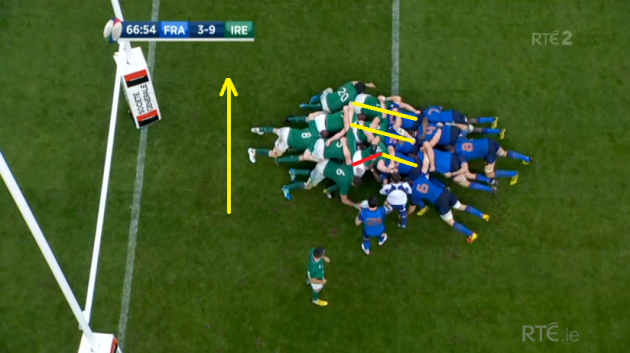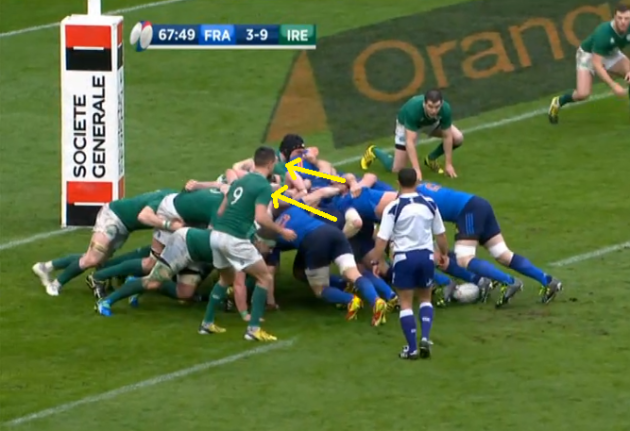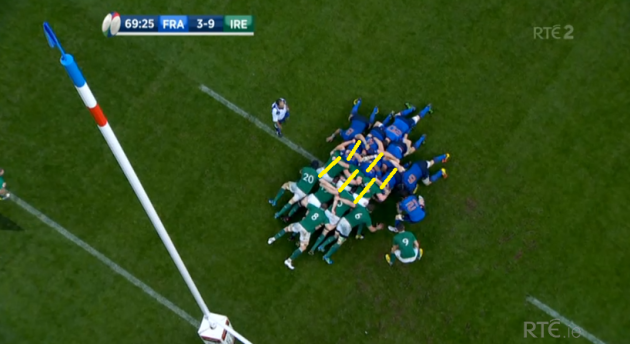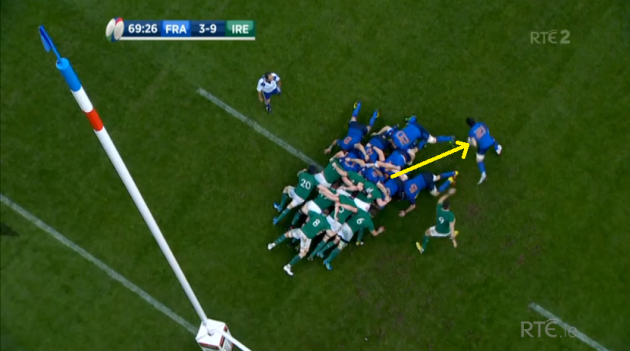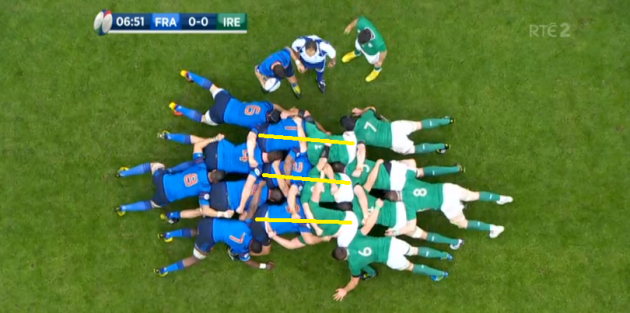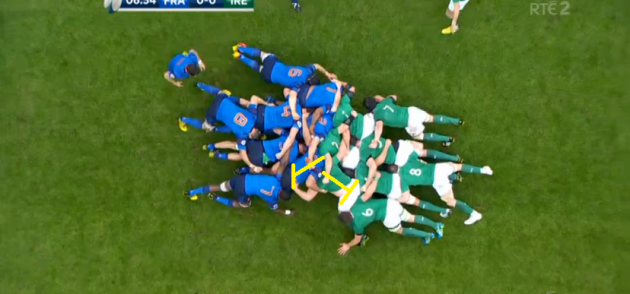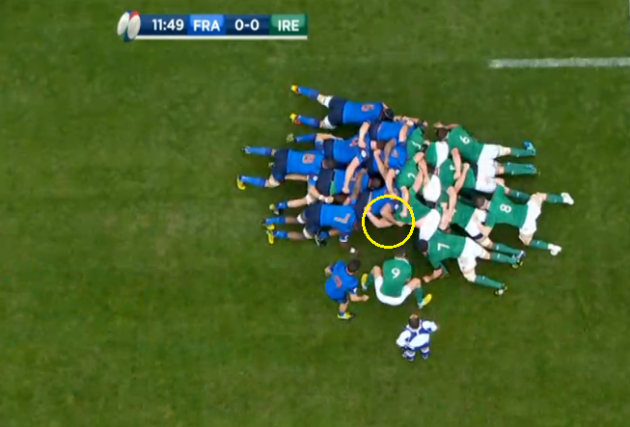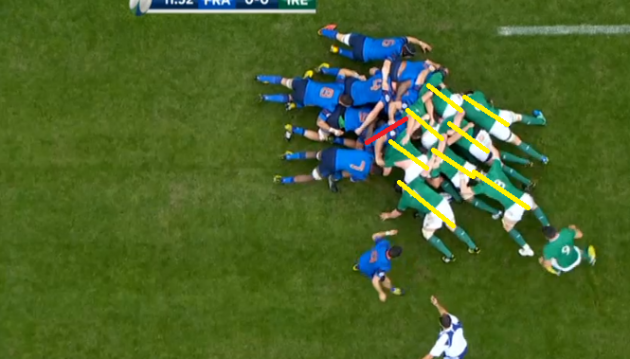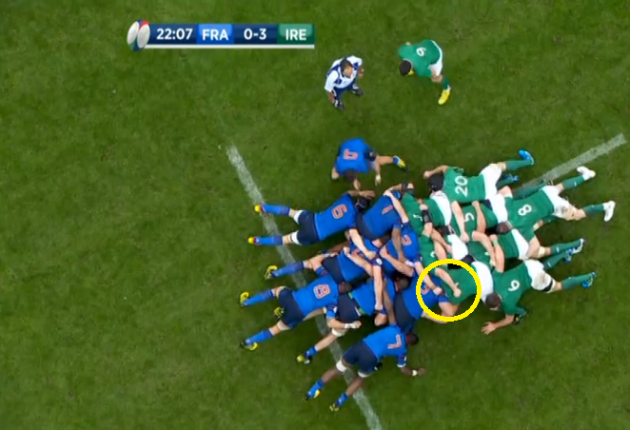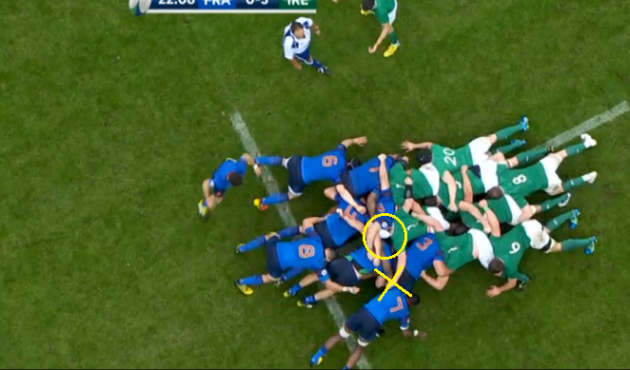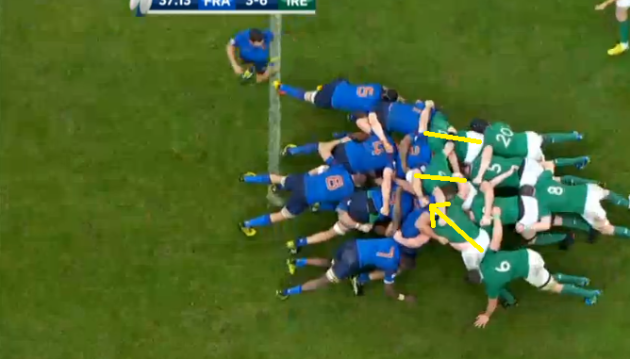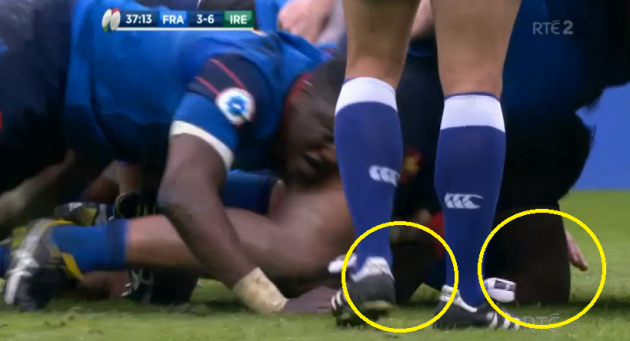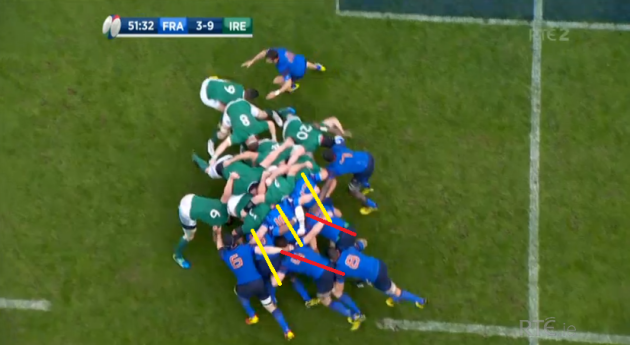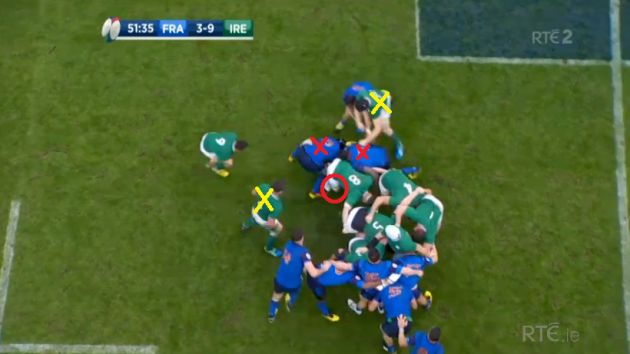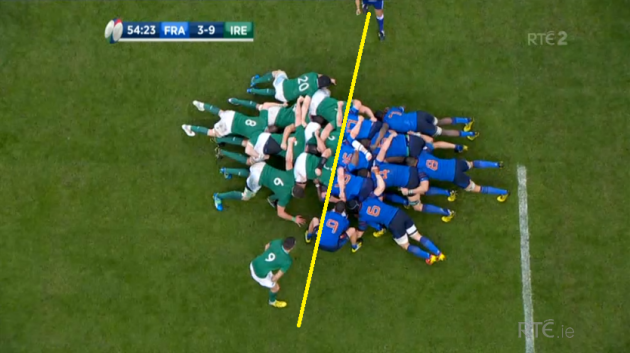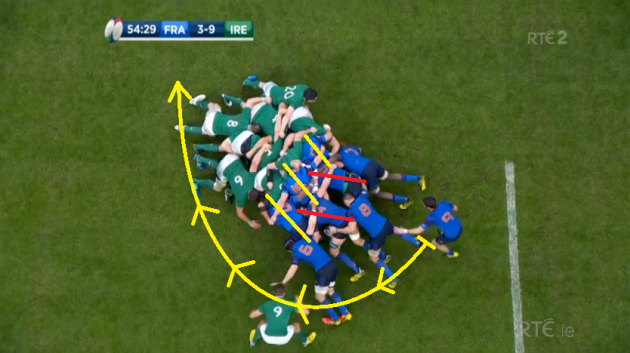I SAW AN opinion floating around that Guy Novès pulled off a tactical masterstroke by keeping Rabah Slimani and Eddy Ben Arous in reserve until the second half of France’s win over Ireland on Saturday.
The idea was that with Ireland’s scrum suffering a tough afternoon against the Welsh, bringing his first-choice duo on when there were tired bodies around would mean it was advantage France.
With hindsight, that’s exactly what happened. The pair were brought on early in the second period, and with the pressure they put on the Irish front row in those four scrums close to the Irish tryline, their impact was huge.
However, to suggest that Novès got his tactics spot on seems a bit of a stretch. Had the pair started the game, the likelihood is that the damage done would have been even greater.
The scrums were a mess on Saturday, and it didn’t help the game as a spectacle that there were 20 of them.
Another thing that didn’t help was Jaco Peyper. He lost control of the set-piece, and the players took advantage. Both sides tried their best to make things messy and, like a stressed out babysitter, he looked powerless to control it.
However, for the four scrums that led up to the French try, the only fault you could find in him was a failure to give France a penalty try.
They were the four most crucial drives of the day, and as such, they’re the scrums we’re going to look at first.
In the first of those, Tadhg Furlong was the man pinged by Peyper, and it looks to be a correct call.
On the engage, Furlong appears to have his body turned inside at an angle, and it causes the scrum to crab.
As we can see below, while the other four front rows are lined up square and straight, Furlong and Ben Arous are driving into each other at angles.
However, while Ben Arous eventually does drive sideways, it’s most likely down to the fact that he has to follow Furlong.
The fact that Ben Arous is driving parallel to his hooker initially would indicate that Furlong is the man who initiates the angle.
When the ball does enter the scrum, it simply runs along the pitch towards the sideline, and doesn’t even move an inch closer to, or further away from the tryline. Penalty France.
For the next drive, many thought Ireland were fortunate not to concede a penalty try, and while I can’t deny it was clearly a penalty, the fact that the previous scrum never threatened the goalline means a penalty try probably would have been a little premature.
The aerial shot above the scrum gives us a good indication as to what happens. All six front rows engage square and straight, so the important place to look at is the footwork of Furlong.
After coming under so much pressure, he’s now trying to lock it out, and as a result has his feet are further back from his body than they should be.
We can see his right foot marked with a circle, with the X indicating where he should probably have been positioned. Even though it’s a small distance between the two, the further back your feet go from the ideal position, the less manoeuvrability you’ll have when the drive comes on.
And when the camera moves down to the regular angle, we can see that once some pressure comes on, Furlong’s right knee drops to the ground.
France keep pushing straight, and with Furlong having dropped, he eventually folds inside.
As we can see in the video below, France power towards the line, and the penalty once again arrives. Peyper could potentially have given a penalty try, but it’s far from the biggest mistake he made in the game,
Ireland were now under enormous pressure, and with a penalty try looming, Jack McGrath got tactical at the resulting scrum, collapsing before France started to march Ireland back.
Because a penalty try can only be awarded if “a try would probably have been scored but for foul play,” then collapsing a scrum on the spot, or in Furlong’s earlier case sending the scrum sideways rather than towards the goal, the referee probably can’t reach that conclusion.
Using hindsight for the second time today, Ireland would probably have been better off conceding a try on one of those earlier scrums, given the energy they used up over the course of the four minute spell.
After three scrums where they dominated Ireland, it actually took a bit of pot luck for France to go over the line. We wrote about the try in detail yesterday, but for the benefit of the piece we’ll take a quick look again.
As they pack in, everything is fine. The scrum is straight and square.
After Machenaud feeds the scrum, it flies out the number one channel before anybody can even blink.
Luckily for France, the scrum-half reacts fastest and scoops up possession immediately, with number eight Loann Goujon’s foot still attempting to control the ball long after it’s left.
Coincidentally, the try Wales scored against Ireland at the Aviva in round one was in practically identical circumstances.
Wales picked off a series of penalties from the Irish scrum and continued to pack down, before a ball popped out the side of a scrum, and Faletau crashed over.
It’s something worth noting though; brute force isn’t always the answer. Oftentimes, a scrum that can secure fast ball has the best returns.
Early days
The day had started well for Ireland, but some of it was down to McGrath attacking Uini Atonio at an angle.
With the French tighthead having such a large frame, McGrath drew a target under his chest and attacked it.
We’ll start by looking at how the initially set up. Again, everything is as it should be.
However, once the ball is fed, we can see that McGrath pops his backside out and starts to drive at an angle.
While both players appear to be pointing into the scrum, the direction of their hips gives an indication as to who is causing it.
We can see that McGrath’s hips are in line with his body, while Atonio’s body is facing into the scrum, with his hips still square.
The scrum then crabs along the spot, moving several yards sideways before France get the ball out again.
Five minutes later we have a similar looking scrum, but on close inspection, this time it’s Atonio who causes McGrath to come in at an angle.
If we look at the initial shot, Atonio has a very short bind on McGrath, pulling his left shoulder down and into his body.
Atonio tries to attack the gap between Rory Best and McGrath, but the Irish players remain tightly bound, and are all driving in the same direction as a group of eight.
Atonio begins to point upwards and drive in, and as a result McGrath follows.
It’s a strong collective shove by Ireland, and it puts the French on the back foot.
However, on the next scrum, the France tighthead does an excellent job of splitting McGrath from Best.
In the picture below, it’s important to watch where Best is bound on McGrath, which is circled.
Best attempts to drive, but slowly starts to pop up, eventually completely losing his grip on McGrath. While Best moves forward, McGrath doesn’t budge Atonio and, as we can see below, the Irish hooker eventually ends up bound on the French back row, with McGrath now completely isolated.
If we watch it back as a whole, we can see that as Best tries to drive up through the scrum, he completely loses his bind on his loosehead and Peyper spots it, with France awarded the penalty.
Aerial shots can give us a great indication of the angles players are driving at, but sometimes, it doesn’t tell the whole story.
Just before half time Ireland were awarded a penalty at the scrum, which Sexton kicked to make it 9-3, but at the time I was adamant that Ireland had conned the referee.
The aerial picture showed us McGrath driving straight in at an angle on the French scrum, which eventually folded.
However, watching the scrums back, a close up shot low to the ground a couple of seconds earlier shows us why this happened.
Just before McGrath’s angle changes, we can see how the left knee of Uini Atonio, and the left knee of his hooker Guilhem Guirado drop to the ground.
With each player now having no support on the left side of their bodies, any pressure coming in from Jack McGrath causes the scrum to cave in. The angle in the earlier shot was actually born out of the French players falling inside.
Peyper actually made some decent decisions at the scrum, but his biggest problem was failing to keep Slimani and Ben Arous under control after they were entered the game on 44 minutes.
For each of the first four scrums that the pair were on the pitch, at least one reset (and sometimes more) was needed.
It took Peyper until the fifth scrum to lose his patience and give a free kick.
In last week’s preview of the French scrum, one thing we highlighted was France’s tendency to wheel, especially when Slimani is playing.
And soon after he entered the game, we saw it happen twice. Unfortunately, the referee clearly hadn’t done his homework.
In the first of the instances, Ireland just about retain possession, with Jamie Heaslip performing a miracle to get the ball out of the scrum under pressure from three French players.
They had been forced to scramble after the French whipped the scrum around 90 degrees, and as we can see below, it was caused by the second rows, who are angling into their props, causing the scrum to rotate.
It’s hard to tell what happens at the base of the scrum. Murray attempts to go for the ball, but is knocked back by Sébastien Bézy.
It seems that Peyper then signals that the ball is in play, and as we can see below, Heaslip somehow manages to retain the possession, despite having a scrum half and two flankers trying to disrupt him.
If Peyper missed a trick by not spotting the wheel that time, three minutes later he made an even bigger howler, awarding France a penalty after a near identical drive.
The only difference was that this time it was on a French put in. Referees weigh their decisions far too heavily in favour of the team holding possession.
Here is how they line up. Note the five-metre line just behind the French back foot. This provides a good reference point for the movement of the scrum.
And just like the previous scrum, we can see the change in direction of the second rows, and how they drive to the left.
Think of a truck jack-knifing, and it’s the same principle. The second rows cause it to whip around, but if we actually look back to the five-metre line, we can see that while the French have moved the scrum quite a distance, they have barely moved it forward at all.
It was this period in the middle third of the game that Peyper made a mess of. Continuous resets without taking action allowed the scrums turn into a farce.
In total there were 20 scrums, although factoring in resets, the front rows probably engaged on closer to 30 occasions throughout the game. Only once did Peyper penalise the team putting the ball in, an indication of just how much leeway attacking teams are given.
While we could barely complete a scrum in the 20 minutes after half time, all of a sudden, the French front row had no trouble keeping it alive when they could smell blood close to the Irish try line.
And as soon as they had their try, things just got messy again.
